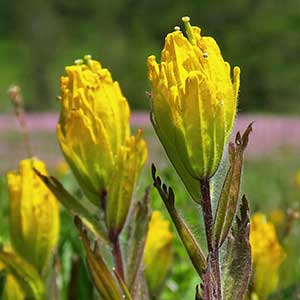Castilleja levisecta
Castilleja subinclusa
golden Indian paintbrush, golden paintbrush
Franciscan paint brush, longleaf Indian paintbrush
few to many, erect, ± decumbent or creeping at base, unbranched, sometimes branched, hairs spreading, medium length and long, soft, mixed with short stipitate-glandular ones.
solitary or few to many, erect to ascending, often leaning on nearby shrubs (var. jepsonii), unbranched or branched, often with small, leafy axillary shoots, hairs matted to spreading, short and long, soft, mixed with short stipitate-glandular ones.
green to purple or brown-tinged, linear-lanceolate proximally, oblong-ovate or -obovate distally, 0.8–5.2 cm, not fleshy, margins plane, distalmost sometimes ± wavy, involute, 3–7(–11)-lobed, apex obtuse;
lobes erect to ascending, linear to linear-spatulate, very short, toothlike, usually arising from distal 1/3 of blade, apex rounded.
green, pale gray-green, sometimes dull reddish purple, linear to narrowly, sometimes broadly, lanceolate, 2–10.5 cm, not fleshy, margins plane, sometimes ± wavy, flat or involute, 0(–3)-lobed, apex acuminate to acute;
lobes spreading, linear to short-lanceolate, often arising near mid length, apex acute to obtuse.
2.5–25 × 1–4 cm;
bracts bright yellow throughout, or proximally greenish, distally bright yellow, sometimes deep yellow-orange, especially with age, oblong, elliptic, or obtuse to ovate, (0–)5–9(–13)-lobed, sometimes wavy-margined;
lobes erect to ascending, oblong, short to medium length, arising above mid length, central lobe apex rounded, lateral ones rounded to acute.
3–30 × 1–7 cm;
bracts green or dull purple throughout, or proximally green or dull purple, distally bright red to orange-red, sometimes salmon, orange, or yellow, usually linear to lanceolate, distal sometimes broadly lanceolate to oblong or elliptic, 0(–3)-lobed;
lobes spreading to erect, linear to oblong or triangular, short or medium length, arising near or above mid length, apex acute to obtuse.
straight or slightly curved, 17–28 mm;
tube 12–15 mm;
beak exserted, adaxially green or greenish yellow, 6–8 mm;
abaxial lip yellow or greenish, reduced, not inflated, 2–3 mm, 25–33(–50)% as long as beak;
teeth ascending to erect, yellow, 0.5–1.5 mm.
curved proximally, straight to slightly curved distally, 25–57 mm;
tube 15–29 mm;
beak subequal to or exceeding calyx but abaxial lip, beak, and often part of tube usually exserted out abaxial cleft;
beak adaxially green, yellow-green, or yellow, 13–21 mm, margins red, orange, or yellow;
abaxial lip green, yellow, reddish, blackish, or deep red-purple, reduced, protuberant, forming a platform, 1–2 mm, 5–25% as long as beak;
teeth ascending, green, purple sometimes with reddish tip, yellow, or blackish, 0.5–1 mm.
distally yellow, 13–22 mm;
abaxial and adaxial clefts 4–9.5 mm, 30–40% of calyx length, deeper than laterals, lateral 2.5–4.5 mm, ca. 25% of calyx length;
lobes linear to narrowly oblong or narrowly lanceolate, apex obtuse, sometimes rounded to acute.
proximally pale green, rarely pale purple, distally bright red or red-orange, rarely orange or yellow, or bright red or red-orange throughout, 20–42 mm;
abaxial clefts 13–27 mm, adaxial 7–17 mm, abaxial 40–70% of calyx length, adaxial 12–33% of calyx length, deeper than laterals, lateral 0–7.5 mm, 0–35% of calyx length;
lobes linear to narrowly triangular, strongly curved away from stem proximally and distally obviously curved toward stem, apex acute to acuminate to obtuse.
= 24.
= 24, 48, 72, 96.
Castilleja levisecta
Castilleja subinclusa
Castilleja levisecta is listed as threatened in the United States and endangered in Canada, where it is extremely rare. Most of its grassland habitat has been altered by development in the Puget Trough, and there are historical stations in the metro areas of what are now Victoria, Portland, and Seattle. For several decades, C. levisecta was considered extirpated from Oregon. However, recent reintroduction programs in Oregon and Washington have been very successful at reestablishing this species at several sites in the Willamette Valley. The bright yellow inflorescences often gradually age to a golden yellow color, unique in the genus.
Castilleja levisecta is in the Center for Plant Conservation’s National Collection of Endangered Plants.
(Discussion copyrighted by Flora of North America; reprinted with permission.)
Varieties 3 (3 in the flora).
Castilleja subinclusa is divided into three varieties with somewhat discontinuous ranges. Identification of the varieties is often difficult when comparing only a single trait but is more easily accomplished when the characters are considered in a suite. The three varieties are also separable by range and habitat.
(Discussion copyrighted by Flora of North America; reprinted with permission.)
1. Corolla beaks adaxially bright yellow, sometimes greenish yellow near apex, margins yellow, rarely orange or red, strongly contrasting with color of calyces; stems and leaves greenish, sometimes dull reddish; lateral calyx clefts 0–4 mm; coastal scrub communities; coastal c California. | var. franciscana |
1. Corolla beaks adaxially green to yellow-green, rarely yellow, margins red to orange, rarely yellow, not strongly contrasting with color of calyces; stems and leaves greenish, pale gray-green, or dull reddish; lateral calyx clefts 3–7.5 mm; dry, sandy or rocky slopes, desert scrub, foothill woodlands, chaparral, brushy openings in pine-oak woods; w foothills of Sierra Nevada in c California or sw California. | → 2 |
2. Stems and leaves greenish, sometimes dull reddish; bracts (0–)3-lobed; brushy openings in pine-oak woods; mostly in w foothills of Sierra Nevada in c California. | var. subinclusa |
2. Stems usually dull reddish; leaves usually pale gray-green to ± ash-colored; bracts 0(–3)-lobed; dry, sandy or rocky slopes, desert scrub, foothill woodlands, chaparral; sw California. | var. jepsonii |


